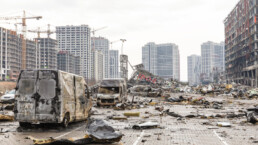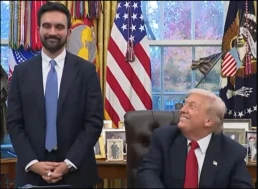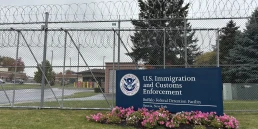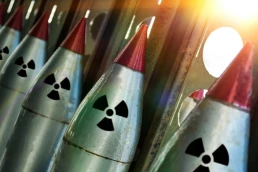Given the official U.S. optimism over Ukraine’s counteroffensive, Barbara Koeppel concludes that Washington has not learned any lessons from failed wars in Vietnam, and later Iraq and Afghanistan.
By Barbara Koeppel, Consortium News
At the end of 1967, the Vietnam War was a stalemate — at least to those who could see straight. Some, like Gen. William Westmoreland, who commanded the American forces, couldn’t.

Thus, in November 1967, Westmoreland claimed “a new phase is starting” in Vietnam.” What’s more, he “could see the light at the end of the tunnel.”
Despite his rosy reckoning, the North Vietnamese and Viet Cong launched the Tet Offensive two months later, attacking over 100 cities in South Vietnam —even the U.S. embassy in Saigon.
To bolster the half million U.S. troops there, Westmoreland asked President Lyndon Johnson for 200,000 more. Johnson said no and recalled Westmoreland to Washington. The war dragged on for seven more years, killing roughly 3.8 million Vietnamese civilians and troops and 58,000 U.S. troops.
Could failed wars in Vietnam and later Iraq and Afghanistan offer lessons for Ukraine? It seems not.
Although the much-heralded Ukrainian counter-offensive begun in June seems to have stalled, The New York Times has routinely interviewed officials and defense analysts in Ukraine, the U.S. and Europe who are optimistic.
On Aug. 21, its front-page story “Ukraine Troops on Front Line Laud Offensive,” quotes a battalion commander who says “with cunning and Western equipment, the Ukrainian armed forces are breaking through their (Russian) defenses. Success is just a question of time.”
Similarly, on Aug. 18, sources at the Institute for the Study of War, a Washington-based think tank, told the NYT the counter-offensive had made “tactically significant gains.” The group gets its core funding from defense contractors.
Drawing from the Westmoreland playbook, on Aug. 14, Phillip M. Breedlove, a retired four-star U.S. Air Force general and go-to authority in New York Times pieces, said “we have not given Ukraine the tools it needs” — although as of this month, the U.S. had sent nearly $77 billion in humanitarian, financial and mostly military aid. Breedlove also touted Ukraine’s military as “one of the best equipped and most battle-tested in Europe.”
On Aug. 3, the Times quoted “defense analysts” who claimed the “Ukrainians were beginning to wear down Russian troops and artillery.” They didn’t mention lights or tunnels, but the words were eerily similar.
Even as recently as Sept. 11, the Times quoted Gen. Mark Milley, chairman of the Joint Chiefs of Staff, who acknowledged the counteroffensive had “gone slower than anticipated.” But he added that “the Ukrainians are still plugging away with steady progress.”
Perhaps the Times’ general support for the war — the paper has run very few stories to the contrary — is not surprising: at least two members of its Board of Directors have close links to the defense industry.
For example, Robert Denham, on the board from 2008 to 2021, is a partner at the law firm of Munger, Tolles and Olson, which represents Boeing, Northrop Grumman, Lockheed Martin and Raytheon. Beth Brooke, who joined the board in 2021, is global vice-chair of public policy at Ernst & Young, which lists Lockheed Martin as one of its “largest clients.”
A Times story on Ukraine on Thursday quotes Ben Barry, a fellow at the U.K.’s International Institute for Strategic Studies. He says, “Ukraine’s ‘deep battle’” against targets far behind enemy lines “has shown signs of success in disrupting Russian military operations” that “may set Ukraine’s forces up for breakout success or diminish Russia’s combat power.”
The Institute is funded by Lockheed Martin, the U.S. State Department and the U.K. Ministry of Defence, among others. The group Transparify gives the Institute the lowest rating, “deceptive,” on funding transparency.
The Times is not alone in opting to interview the optimists. On Aug. 23, The Washington Post quoted National Security Advisor Jake Sullivan, who said “we do not assess that the conflict is a stalemate.”
A few mainstream media take a more nuanced view. For example, on Aug. 20, the Financial Times noted that “US officials are increasingly critical of Ukraine’s counteroffensive strategy and gloomy about its prospect of success.”
And on Aug. 20, The Economist wrote that “hopes of a quick breakthrough have dwindled.” Even The Washington Post noted on Aug. 17 that “nearly all analysts agree that Russia surpassed expectations when it comes to its proficiency in defending occupied territory.”
Some analysts whom the mainstream media don’t quote see a tragedy.
Lawrence Wilkerson, a retired U.S. Army colonel and former special assistant to the chair of the U.S. Joint Chiefs of Staff (Gen. Colin Powell), told the podcast Dialogue Works, that:
“as a military professional, it’s clear to me the war has been a recipe for complete defeat. Any military expert not paid by the media or isn’t stupid knows this is an uneven contest even with NATO throwing everything it can except its own soldiers into the battle. Yet we’re backing them to the last dead Ukrainian. … The Ukrainians are surely fighting for the things all of us would fight for. But we’re cheating them because they’re not going to win. Look how many people they’re losing. From that you don’t recover.”
Wilkerson’s calculus is based on the
“extreme imbalance of forces. You’ve got a nation with 140 million people up against one that has gone from 40 million down to about 30 million. Russia has the numbers, ferocity, depth and stubbornness that comes with that. It also has one of the world’s most robust industrial bases that even the Nazis couldn’t overcome in WWII with one of the best armies on the face of the Earth. … What Putin has done is cruel and brutal. But he’s reacting to what we did by expanding NATO and putting ballistic missiles with nuclear capabilities in new NATO countries.”
Further, Wilkerson says “it was hogwash that Putin threatened the rest of Europe. We and London played that up because we thought that would solidify NATO. This is dangerous.”
Moreover, on Sept. 7, Jens Stoltenberg, general secretary of NATO, told the European Parliament’s Committee on Foreign Affairs that Putin wanted us to promise “never to enlarge NATO….close to his borders. We rejected that. So he went to war to prevent NATO expansion.”
Wilkerson doubts the wisdom of officials interviewed on CNN and other mainstream media. He points to David Petraeus, the retired U.S. Army general and past director of the C.I.A., who claims we must provide Ukraine with new weapons. Wilkerson said:
“These sources aren’t changing their minds because they’re caught in their own rhetoric. I would ask David, whom I’ve known for some time, when’s the last time you won a war? He lost in Iraq. He lost in Afghanistan. He had to resign from the C.I.A. So I wouldn’t take David’s advice on how to pickle a herring. Nor would I take the advice of most generals or admirals speaking on television because they’re part of the empire’s war machine. Overall, NATO’s path has been incredibly ill-advised: We had an opportunity post-Cold War to make Russia a part of Europe in a genuine way. But we didn’t.”
Wilkerson fears what can happen when you “start losing badly — unless you’re willing to escalate majorly. Not just nuclear but also the conventional part. If you go down this dangerous road, you begin to provide F-16s. Then you fly the airplanes yourself and come into the war more forcefully. No troops on the ground yet, but that ultimately will happen. And then you’re in a World War. So nuclear powers must avert confrontations that bring adversaries to a choice of either a humiliating retreat or a nuclear war — which is a collective death-wish for the world.”
Wilkerson’s predictions were partially realized on Aug. 21 when the Times reported that the Netherlands and Denmark will donate 61 F-16 fighter jets to Ukraine “once pilots and engineers are trained.”
President John F. Kennedy warned of such dangers in his 1963 commencement address at American University:
“Total war makes no sense when great powers maintain large and relatively invulnerable nuclear forces and refuse to surrender without resorting to them.”
JFK stressed diplomacy, as does Wilkerson, who says “it would work if people were serious about it. But they’re not because they make too much money off these wars — money that goes into U.S. political coffers and into Moscow’s oligarchs’ coffers.”
Wilkerson notes that in the late 1930s,
“Dupont and Ford Motor Company sold supplies to Hitler and Ford even sent them during the war. You then understand that we’re staying in Ukraine because we’re making fortunes off of it — Lockheed Martin and Raytheon, in particular.”
Toxic Outcome
There’s also the issue of noxious hazards when the war ends. In an interview, Matthew Hoh, associate director of the Eisenhower Media network, a Marine veteran and State Department consultant who resigned over the escalation of the Afghan war in 2009, warned,
“Ukraine will be toxic for decades. First, there are the ‘duds’ — the shells, missiles, bombs and grenades used by both sides — that don’t explode. Even if the dud rate is only one percent, that’s an astounding amount of unexploded ordnance. We’ve seen what happened elsewhere.”
As late as 2016, Smithsonian Magazine reported “thousands of tons of unexploded bombs are in Germany, left over from World War II.”
In Vietnam, the non-profit, “Project Renew,” has removed thousands of unexploded bombs in Quang Tri Province, alone.
And NBC News reported on Aug. 11 that in Poland, “builders working on a new residential area uncovered a mega-bomb buried in the ground, also from WWII.”
Further, pollution from war materials is extensive. Hoh explains, “When thousands of tanks or other military vehicles are blown up, the fuel and oil lubricants spill out, as do the vehicle’s explosives.
“Also, both sides have placed millions of land mines. Though warring countries are expected to track where they put them so they can remove them when the war ends, often they’re not recorded. Worse, many were moved by the massive flood when the Kakhovka Dam in eastern Ukraine broke on June 6. They could be anywhere.”
Moreover, Hoh points to the toxicity of weapons made with depleted, undepleted and slightly enriched uranium, as were used in Iraq and Afghanistan. He asks “how many generations of Ukrainian women are going to give birth to deformed kids? How many will get cancer?”
According to the World Health Organization, in 2004 Iraq had the highest leukemia and lymphoma rates in the world, closely followed by Afghanistan.
“Regardless of who wins, they’ll win a land that’s destroyed, toxic, and filled with unexploded bombs and shells,” Hoh says.
Barbara Koeppel is a freelance investigative reporter based in Washington, D.C.
Recent Posts
The Trump-Mamdani Show Was Amazing. But Downsides For Progressives Could Turn Out To Be Steep
November 25, 2025
Take Action Now It’s all well and good to laud Mamdani’s extraordinary political talents and inspiring leadership for social justice. At the same…
ICE Sent 600 Immigrant Kids To Detention In Federal Shelters This Year. It’s A New Record.
November 24, 2025
Take Action Now This year ICE has sent more immigrant children into the federal shelter system than in the previous four years combined. New data…
The Return Of Nuclear Proliferation
November 24, 2025
Take Action Now A recent article in the establishment security journal Foreign Affairs makes the case for nuclear proliferation among America’s…
Are Zohran Mamdani and Katie Wilson Democratic Socialists or FDR Democrats? They Are Both
November 23, 2025
Take Action Now This is fitting: For more than a century, socialism has been integral to American progressivism, championing early many of the…




